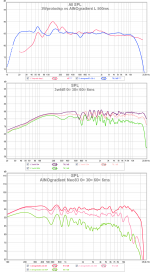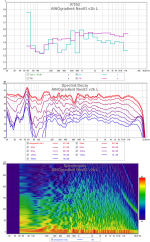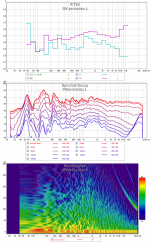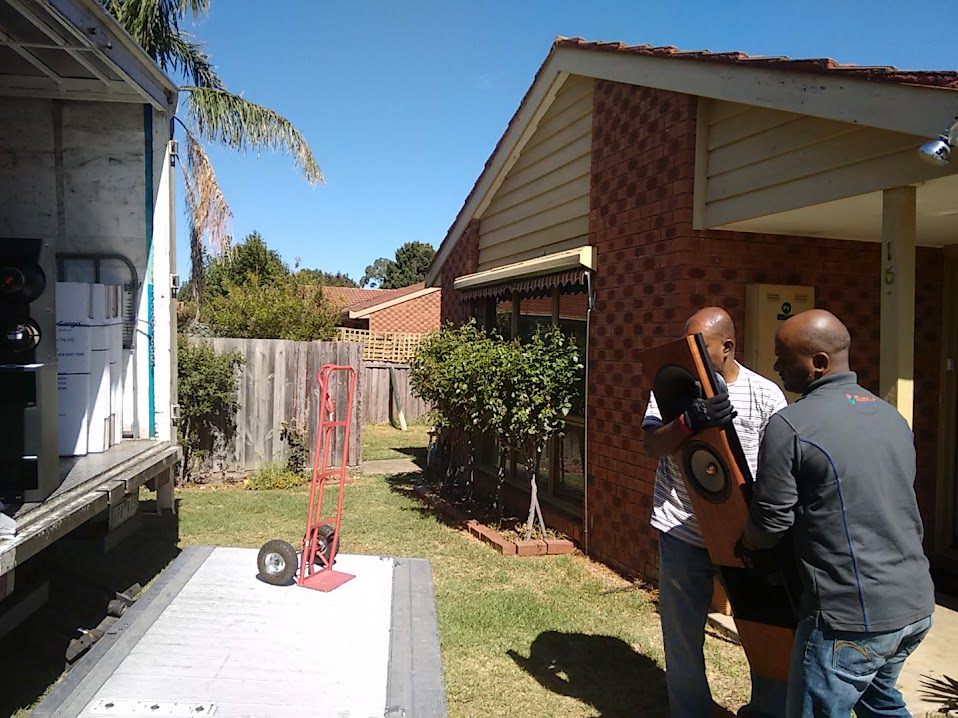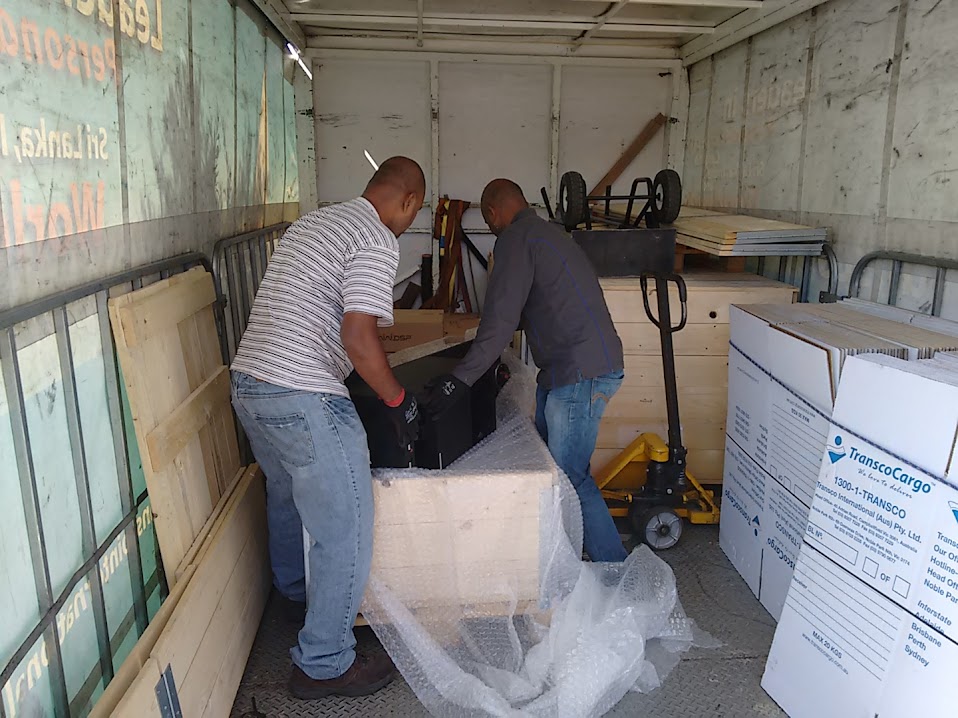directivity
I believe that flat power response is important. Our perception of loudness in rooms is dominated by reverberant field not a direct sound only. And reverberant field is related to power response.So perceived loudness is proportional to power response. We listen to loudspeakers+room system. If we are talking about living rooms, our ears are adopted to room characteristics very well. We could say that our ear-brain system acts as our room inverse filter. So room is virtually eliminated from loudspeakers+room system in terms of reverberant field (loudness) perception.
From the listening experience i can say that more flat ant more uniform polar response is more pleasant to listen. If i move or turn my head i don't hear sharp changes in reflection pattern. If i listen to loudspeakers which directivity is very uneven i must listen completely still. If i move ,turn head the reflection pattern tells me were loudspeakers are located easier compared to flat constant directivity case. I feel not comfortable,unpleasant feeling.(our ears are directional recievers)
Also one very good listening test is to put loudspeakers in the other room. If the path from loudspeakers in another room is not one simple reflection way but more complicated path. Then you can listen to reverberant field. And eliminting the direct sound is easier to evalute the loudspeakers in terms of power response. Flat power response loudspeakers sounds so realistic from another room that i was thinking to make test with real musician and his recorded play for comparison. But didn't do that yet.
I am not talking about putting loudspeakers very close to the front wall which gives a lot early reflections. In such case if someone looses the direct/reflected ratio doesn't mean at all that that flat power is wrong!
I believe that flat power response is important. Our perception of loudness in rooms is dominated by reverberant field not a direct sound only. And reverberant field is related to power response.So perceived loudness is proportional to power response. We listen to loudspeakers+room system. If we are talking about living rooms, our ears are adopted to room characteristics very well. We could say that our ear-brain system acts as our room inverse filter. So room is virtually eliminated from loudspeakers+room system in terms of reverberant field (loudness) perception.
From the listening experience i can say that more flat ant more uniform polar response is more pleasant to listen. If i move or turn my head i don't hear sharp changes in reflection pattern. If i listen to loudspeakers which directivity is very uneven i must listen completely still. If i move ,turn head the reflection pattern tells me were loudspeakers are located easier compared to flat constant directivity case. I feel not comfortable,unpleasant feeling.(our ears are directional recievers)
Also one very good listening test is to put loudspeakers in the other room. If the path from loudspeakers in another room is not one simple reflection way but more complicated path. Then you can listen to reverberant field. And eliminting the direct sound is easier to evalute the loudspeakers in terms of power response. Flat power response loudspeakers sounds so realistic from another room that i was thinking to make test with real musician and his recorded play for comparison. But didn't do that yet.
I am not talking about putting loudspeakers very close to the front wall which gives a lot early reflections. In such case if someone looses the direct/reflected ratio doesn't mean at all that that flat power is wrong!
If we are talking about living rooms, our ears are adopted to room characteristics very well. We could say that our ear-brain system acts as our room inverse filter. So room is virtually eliminated from loudspeakers+room system in terms of reverberant field (loudness) perception.
Please ignore the sentence above. Late night writing mistake.
Agreed. My link was not supposed to be an explanation, but just a hint that there is a frequency-dependent component of the precedence effect. Still need to do some research in that area. It might not be the precedence effect, it could simply be the fact that high-frequency reflections are more specular.Hi,
"echo" plays no role in a small room's early reflections.
Unless it is placed close(< 1m or 6ms delay) to the front wall, as in my case.There is no problem in a real dipole (constant DI 4.77 dB) being operated fullrange.
It is precisely the room setup, reflections, etc. that make a loudspeaker sound good or bad. You can build a speaker using a generic approach like full dipole and then try to address the issues in the room (painful) or you can incorporate the room constraints in the setup - which was my initial point against using full-XXX.The frequency dependencies you are reporting seem due to
- personal taste
- room setup (which reflections active, which spectrum, "degree of diffusion" IACC, etc. ...)
- isdiosyncratic dispersion of the speaker
- ... etc.
It's not about echo, see my first comment.At same level of the direct sound, the threshold for perceiving an "echo" may be about 20 ... 30ms. That is a pathlength of > 7meters at least ...
I did not say it would not work. I said it might work differently.There is also no indicator, that precedence effect would not work for frequencies say >2Khz.
I have found some papers on the subject, but not all support my assumption. It's been found out that the precedence effect is asymmetric in frequency in the sense that the effect is significantly larger with a low frequency sound leading a high-frequency sound than the other way round. This would mean that a high-frequency reflection should be more easily masked. Here's the paper: http://www.cns.bu.edu/~shinn/resources/pdfs/2000_and_earlier/1995JASA_Shinn.pdf
OTOH, Toole's book has an example where a low-passed reflection needs to be ~3dB higher in level than the same unfiltered reflection in order to influence localization, which does support my point. So it's a bit confusing, also because different authors have slightly different takes at what "high frequency" means.
You seem to imply that spaciousness is only given by side walls reflections, which is not necessarily true, nor is it the optimal solution in small rooms - due to potential imaging issues (there is always almost a trade-off between imaging and spaciousness). Griesinger has studied this subject extensively and found out spaciousness vs. localization is largely a matter of D/R ratio (which should be under a frequency-dependent threshold) and in small rooms it's only ESI (early spatial impressions) due to the propagation times that are too small for "true" spaciouosness. Toole also quotes him in his book. Linkwitz also states on his LX521 site: "I consider it more important to minimize the side wall reflection and to diffuse, not to absorb, the front wall reflection for optimal imaging.""True fullrange dipoles" - few listeners have experience with something coming even close to that - typically cause few side reflections when setup in a usual way due to the nulls in radiation pattern at 90 degree from the speaker's main radiation axis. Thus fullrange(!) dipoles will simply sound "too dry" for many listeners.
Even cardioids and usual waveguides will provide more side reflections in most setups. So i think this is what you are looking for: Increasing spaceousness by increasing the amount of side reflections >2Khz, that are arriving at the listening seat at angles e.g. about 60 degrees from the median plane (front). Those tend to increase IACC and perceived "spaceousness"
A non-issue if speakers are placed along a long wall (far from the side walls) and the strongest reflections are off the front wall. Again, it's a matter of room setup.And by going from dipole to e.g. cardioid in the highs only, those side reflections will have less bass and mid frequency content than in common speakers.
Thus analysis of early sidewall reflections will even show a highpass filtered spectrum of early side reflections with your proposed kind of loudspeaker, which is contrary to your analysis.
I understand your desire for simplicity. But things sometimes are just complicated.That is all to it IMHO ... no complicated explanations needed in my view.
BTW. regarding just "energy response" and "directivity index" dipole and cardioid pattern are "compatible": Both have DI of 4.77dB.
http://www.knowles.com/eng/content/download/2807/32862/version/6/file/an-4-issue01.pdf
Just the reflections caused in a given room and setup will be different, as pointed out above.
Which supports the idea of mixing them for optimal in-room integration rather than blindly following a full-XXX solution.
Hi bzfcocon,
just a remark due to "side reflections" and "spaceousness"
Using a dipole "side reflections" - i meant reflected sound arriving from side angles at the listening seat - may also be produced by multiple reflections using e.g.:
"left speaker - left side wall (corner) - front wall - right side wall - listener"
But such setups are not possible in every room an may need special design of corners and/or large amounts of "toe in". Latter is IMO no good practice with fullrange dipoles, as one potential major advantage is diminished then, which is good modulation transfer in mid and upper bass:
With large amounts of toe in, one has to ask why using dipoles at all IMO.
Unfortunately with fullrange dipoles (e.g. large panel ESL), you will need significant toe in in most settings because of beaming in highs. But for the bass usually a dipole axis more parallel to the longer axis of the room is of advantage (given the setup is optimized to do so): This rises the question whether a "conventional fullrange dipole" is a good concept in itself.
To me it is kind of problematic. Things change IMO if there is a dedicated subwoofer system and/or the dipole axis can be "twisted" at least somewhere in the mid- to upper bass, which calls for a 2-way system at least.
Front wall, ceiling and bottom reflections do not increase IACC and thus neither contribute much to spaceousness nor to clarity.
So it is the side relections to work with, to "heal" a stereo system's inherent drawbacks IMO. But those side reflecions need not be ipsilateral "early reflections" only. It depends on the room dimensions and possible setups which way to go. I prefer a "mix" of ipsilateral and contralateral reflections, which implies haven the ipsilaterals "late enough" and "somewhat down in level".
No simple "one fits all" solution, completely agreed
just a remark due to "side reflections" and "spaceousness"
Using a dipole "side reflections" - i meant reflected sound arriving from side angles at the listening seat - may also be produced by multiple reflections using e.g.:
"left speaker - left side wall (corner) - front wall - right side wall - listener"
But such setups are not possible in every room an may need special design of corners and/or large amounts of "toe in". Latter is IMO no good practice with fullrange dipoles, as one potential major advantage is diminished then, which is good modulation transfer in mid and upper bass:
With large amounts of toe in, one has to ask why using dipoles at all IMO.
Unfortunately with fullrange dipoles (e.g. large panel ESL), you will need significant toe in in most settings because of beaming in highs. But for the bass usually a dipole axis more parallel to the longer axis of the room is of advantage (given the setup is optimized to do so): This rises the question whether a "conventional fullrange dipole" is a good concept in itself.
To me it is kind of problematic. Things change IMO if there is a dedicated subwoofer system and/or the dipole axis can be "twisted" at least somewhere in the mid- to upper bass, which calls for a 2-way system at least.
Front wall, ceiling and bottom reflections do not increase IACC and thus neither contribute much to spaceousness nor to clarity.
So it is the side relections to work with, to "heal" a stereo system's inherent drawbacks IMO. But those side reflecions need not be ipsilateral "early reflections" only. It depends on the room dimensions and possible setups which way to go. I prefer a "mix" of ipsilateral and contralateral reflections, which implies haven the ipsilaterals "late enough" and "somewhat down in level".
No simple "one fits all" solution, completely agreed
Last edited:
Examples for indirect lateral sound arriving at the listening seat using a dipole:
"left speaker - left side wall (corner) - front wall - right side wall - listener"
also
"left speaker - right side wall - listener" ("contralateral reflections": with some amount of toe in, those will even get stronger in level)
...
"left speaker - left side wall (corner) - front wall - right side wall - listener"
also
"left speaker - right side wall - listener" ("contralateral reflections": with some amount of toe in, those will even get stronger in level)
...
But for the bass usually a dipole axis more parallel to the longer axis of the room is of advantage (given the setup is optimized to do so):
Hello,
Could you please explain why? Why is somehow excitation of longer axis modes is better?
About power response:
http://www.theaudiocritic.com/back_issues/The_Audio_Critic_28_r.pdf
Page nr 10 show that most preferred loudspeakers also had flattest power response. It is very likely that completely flat could become the most preferred if they had such loudspeakers. In page 9 Toole says "Diferences among the curves indicate conflicts in the timbral signatures, of direct reflected, and reverberant sounds-something that contradicts natural experience, and that listeners react negatively to."
Sometimes to me seams that precedence effect is over emphasized. Precedence effect talks about locating sound source with reflections present.
This means locating the one speaker itself in a room(where it is placed). We can locate one speaker in a room very good due to precedence. But the goal is not to locate a speaker,the goal is to pass the info (with directional cues encoded) recorded through room reflections to the ears.
This is far out from the topic, but the discussion is very interesting to me. Here I show sets of measurements in my living room. Speakers in same location, baffle 80cm to front wall, 2m to side wall, 30¤ rotated, on-axis to mic which is in stereo hot spot 2,3m away. Speakers are along the long wall.
3Whifi proto dsp is 3-way monopole
AINOgradient is mono to 80Hz, cardioid transition 80-250Hz and dipole 250Hz up
We notice great differencies in edt and high frequency decays, and between 80-200Hz.
Sorry I have not listened to 3W in stereo, but several monopole 2-ways in this room. The dipole sounds the same around the room, acoustic music is very natural, but stereo imaging is more vague, bass is very solid. I like dipoles more than monos here, but an imaging-freak might disagree. I am sure, that if dipoles were given more space to front wall, imaging would be better, because of bigger D/R and shorter EDT.
3Whifi proto dsp is 3-way monopole
AINOgradient is mono to 80Hz, cardioid transition 80-250Hz and dipole 250Hz up
We notice great differencies in edt and high frequency decays, and between 80-200Hz.
Sorry I have not listened to 3W in stereo, but several monopole 2-ways in this room. The dipole sounds the same around the room, acoustic music is very natural, but stereo imaging is more vague, bass is very solid. I like dipoles more than monos here, but an imaging-freak might disagree. I am sure, that if dipoles were given more space to front wall, imaging would be better, because of bigger D/R and shorter EDT.
Attachments
Juhazi said:I am sure, that if dipoles were given more space to front wall, imaging would be better, ...
@Juhazi
80cm distance to front wall is way too short, when using a dipole ...
Diffusers will be of great advantage, if you don't already use some, regardless if you can increase the distance to the front wall in your current setup.
The decay of the cardioid is at least more "balanced" and noteably faster from upper bass on upwards, when compared to the monopole, if i am interpreting your graphs right.
This is why i prefer directional speakers (dipoles, cardioids) even from mid-bass to midrange. I feel that your resultes given by the decay measurements are quite typical, for "good" setups of more directional speakers.
Kind Regards
Last edited:
bzfcocon said:Which supports the idea of mixing them for optimal in-room integration rather than blindly following a full-... solution.
Surely it is not forbidden to think about that
The "full-xy" is not "deficient" by itself just for being "full-xy". But a more adaptive pattern or even a dipole which has the radiaton axis slightly modified (rotated) with frequency, may be a very attractive solution with regard to actual room setup, treatment and furnishing possible.
Sharp discontinuities due to energy response should be avoided IMO.
"80cm distance to front wall is way too short, when using a dipole ..."
I know, and I can pull them 100-110cm off from wall for hardcore hifi-sessions! There are also windows right behind the speakers. This is the main reason for my previous recommendation for longitudinal positioning. Other is getting more distance to back wall naturally.
My room is roughly 3,5 x 6m (too small...) but with open access to diner/kitchen and corridor. Those "cavities" act as resonation chambers below 200Hz. Subopimal but I must live with it, it is the living room.
I know, and I can pull them 100-110cm off from wall for hardcore hifi-sessions! There are also windows right behind the speakers. This is the main reason for my previous recommendation for longitudinal positioning. Other is getting more distance to back wall naturally.
My room is roughly 3,5 x 6m (too small...) but with open access to diner/kitchen and corridor. Those "cavities" act as resonation chambers below 200Hz. Subopimal but I must live with it, it is the living room.
I see your point. I also don't like toe in except for a little a bit - otherwise the auditory scene shrinks too much.Hi bzfcocon,
just a remark due to "side reflections" and "spaceousness"
Using a dipole "side reflections" - i meant reflected sound arriving from side angles at the listening seat - may also be produced by multiple reflections using e.g.:
"left speaker - left side wall (corner) - front wall - right side wall - listener"
But such setups are not possible in every room an may need special design of corners and/or large amounts of "toe in". Latter is IMO no good practice with fullrange dipoles, as one potential major advantage is diminished then, which is good modulation transfer in mid and upper bass:
However one must not forget that dipole directivity is not that narrow - neither at the front nor at the back - and cardioids even less so. There is still significant radiation at 45 degrees (-3dB), sufficient for building up a reverberant field (unless one absorbs them, which IMO kind of defeats the purpose of a dipole).
As to the bass: I also align bass to the listening axis. I am also experimenting using a "spatial equalizer" as per Griesinger, which found out that there is significant low-frequency localization, but it tends to collapse in the middle and thus needs correction. See http://www.davidgriesinger.com/spatialization_and_loc.doc)
This should also help "envelopment" at LF, of which Griesinger says it's a function of the interaural time delay fluctuations (lateral pressure variations)
BTW, he also says IACC does not work well in small rooms at LF and suggests alternative metrics like the AITD: http://www.davidgriesinger.com/overvw1.pdf
For bass dipoles, longer axis modes mean lower bass extension.Hello,
Could you please explain why? Why is somehow excitation of longer axis modes is better?
In short: I don't think anyone will claim power response is unimportant. But it only offers a foundation (the overall balance) and the devil is in details: direct sound, reflections, their timing/quality, etc. Otherwise you'd just design a flat power response loudspeaker with crappy direct sound, put it in a corner and hope it will sound good, which it won't.About power response:
http://www.theaudiocritic.com/back_issues/The_Audio_Critic_28_r.pdf
Page nr 10 show that most preferred loudspeakers also had flattest power response. It is very likely that completely flat could become the most preferred if they had such loudspeakers. In page 9 Toole says "Diferences among the curves indicate conflicts in the timbral signatures, of direct reflected, and reverberant sounds-something that contradicts natural experience, and that listeners react negatively to."
Like it or not, the precedence effect does not care about our goal. It will still happen with reflections and cause apparent sources anomalies (stereo relies on consistent ITD/ILD).Sometimes to me seams that precedence effect is over emphasized. Precedence effect talks about locating sound source with reflections present.
This means locating the one speaker itself in a room(where it is placed). We can locate one speaker in a room very good due to precedence. But the goal is not to locate a speaker,the goal is to pass the info (with directional cues encoded) recorded through room reflections to the ears.
"80cm distance to front wall is way too short, when using a dipole ..."
I know, and I can pull them 100-110cm off from wall for hardcore hifi-sessions! There are also windows right behind the speakers. This is the main reason for my previous recommendation for longitudinal positioning. Other is getting more distance to back wall naturally.
The big problem with moving speakers back and forth is that it significantly changes 1. the tonal balance and 2. the excitation of bass modes (rendering any room eq. useless)
It is precisely why I'm aiming for a solution that works well at 70-80 cm off the front wall. So far, my experiments showed that a rolled-off backwards radiation above 2kHz or so works very well including very good imaging and spaciousness. I achieve the roll-off by partial absorbtion, i.e. putting a sheet of felt on the back of the mid-highs panel). This thread's (which we've kind of hijacked
The big problem with moving speakers back and forth is that it significantly changes 1. the tonal balance and 2. the excitation of bass modes (rendering any room eq. useless)
---
In contrast, maintaining fullrange dipole has disturbing imaging issues.
Based on my experience, you are overreacting! Yes there are channges but not as much as one would think of. Fronwall effects are very sharp, high Q - can not be equalized! I don't use any location-dependent eq. Without speaker rotation situation would be worse. But anyway cardioid response would be ideal for near-wall placement. This is why my speaker is cardioid 80-200Hz!
I gues s you know kimmosto's work of it? Comparison of dipole vs cardioid bass, but difference is not as great as you would guess again.
DIY Loudspeakers Kimmo Saunisto go to Cardioid bass
I think that now I must reveal a secret, because I know that gainphile is not a fan of dipole bass either.
Aino has downfire monopole sub-bass and dipole woofer, crossed LR2 to get cardioid response in transition area. This works fantastically when the speaker is in the middle of the room or outdoors. But when I push it closer to the wall, woofer response shows 10-15dB bump around 130Hz. This is caused by first reflection from the frontwall behind the speaker. This bump can be seen in room response.
Setting xo-point higher and/or steeper would help but then response gets too dry around 2-300Hz. The woofer has now some 5dB Q4 notch set at 130Hz in minidsp eq.
Aino has downfire monopole sub-bass and dipole woofer, crossed LR2 to get cardioid response in transition area. This works fantastically when the speaker is in the middle of the room or outdoors. But when I push it closer to the wall, woofer response shows 10-15dB bump around 130Hz. This is caused by first reflection from the frontwall behind the speaker. This bump can be seen in room response.
Setting xo-point higher and/or steeper would help but then response gets too dry around 2-300Hz. The woofer has now some 5dB Q4 notch set at 130Hz in minidsp eq.
Juhazi said:But anyway cardioid response would be ideal for near-wall placement.
A cardioid placed with the rear "null" towards the front wall should excite only little (direct) reflections off the front wall.
Thus it is rather free in placement due to front wall distance, which typically varies between setups due to practical conditions ...
A cardioid is the most "practical" speaker design from mid-bass on upwards due to placement in my view.
Based on my experience, you are overreacting! Yes there are channges but not as much as one would think of. Fronwall effects are very sharp, high Q - can not be equalized! I don't use any location-dependent eq. Without speaker rotation situation would be worse. But anyway cardioid response would be ideal for near-wall placement. This is why my speaker is cardioid 80-200Hz!
I gues s you know kimmosto's work of it? Comparison of dipole vs cardioid bass, but difference is not as great as you would guess again.
DIY Loudspeakers Kimmo Saunisto go to Cardioid bass
Based on my measurements and ears, I am not overreacting
I think the graphs on Kimmo Saunisto's site are not telling the whole story:
- curves are hard to tell apart
- distance to wall is not easy to guess. I would guess the red position is ~60-70 cm to wall, but the red curve shows a deep - and broad ! - dip centered at ~90Hz, but that does not really sound plausible, as the 70cm dip should have been much higher in frequency.
- a 500 ms window is a bit large.
- only woofer response up to ~200Hz is shown. In my case,
But even he says "Dipole woofer is not so sensitive for a single back wall reflection, but otherwise response variations are bigger". They are indeed large in the area 100-200Hz
For a dipole against a wall there will be at least a large dip at wavelength = 2d and a peak at 4d (where d is distance to wall). As you get closer to the wall, the dip is getting larger and higher in frequency - and more audible.
For d = 80cm, the dip is at 210 Hz, above the modal region and is clearly audible. It must be equalized. For d= 120cm, the dip goes down to 140 Hz and likely much less noticeable. Going even closer than 80 cm will put you in even bigger trouble.
Edit: there is one more thing: http://www.musicanddesign.com/Boundary_reflections.html
Last edited:
- Status
- This old topic is closed. If you want to reopen this topic, contact a moderator using the "Report Post" button.
- Home
- Loudspeakers
- Multi-Way
- R16 constant directivity dipoles
